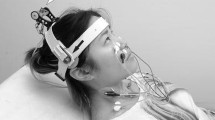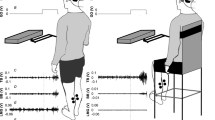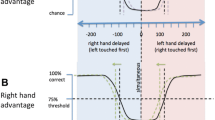Abstract
Proprioceptive input arising from torsional body movements elicits small reflexive eye movements. The functional relevance of these eye movements is still unknown so far. We evaluated their slow components as a function of stimulus frequency and velocity. The horizontal eye movements of seven adult subjects were recorded using an infrared device, while horizontal rotations were applied at three segmental levels of the body [i.e., between head and shoulders (neck stimulus), shoulders and pelvis (trunk stimulus), and pelvis and feet (leg stimulus)]. The following results were obtained: (1) Sinusoidal leg stimulation evoked an eye response with the slow component in the direction of the movement of the feet, while the response to trunk and neck stimulation was oriented in the opposite direction (i.e., in that of the head). (2) In contrast, the gain behavior of all three responses was similar, with very low gain at mid- to high frequencies (tested up to 0.4 Hz) but increasing gain at low frequencies (down to 0.0125 Hz). We show that this gain behavior is mainly due to a gain nonlinearity for low angular velocities. (3) The responses were compatible with linear summation when an interaction series was tested in which the leg stimulus was combined with a vestibular stimulus. (4) There was good correspondence of the median gain curves when eye responses were compared with psychophysical responses (perceived body rotation in space; additionally recorded in the interaction series). However, correlation of gain values on a single-trial basis was poor. (5) During transient neck stimulation (smoothed position ramp), the neck response noticeably consisted of two components – an initial head-directed eye shift (phasic component) followed by a shift in the opposite direction (compensatory tonic component). Both leg and neck responses can be described by one simple, dynamic model. In the model the proprioceptive input is fed into the gaze network via two pathways which differ in their dynamics and directional sign. The model simulates either leg or neck responses by selecting an appropriate weight for the gain of one of the pathways (phasic component). The interaction results can also be simulated when a vestibular path is added. This model has similarities to one we recently proposed for human self-motion perception and postural control. A major difference, though, is that the proprioceptive input to the gaze-stabilizing network is weak (restricted to low velocities), unlike that used for perception and postural control. We hold that the former undergoes involution during ontogenesis, as subjects depend on the functionally more appropriate vestibulo-ocular reflex. Yet, the weak proprioceptive eye responses that remain may have some functional relevance. Their tonic component tends to stabilize the eyes by slowly shifting them toward the primary head position relative to the body support. This applies solely to the earth-horizontal plane in which the vestibular signal has no static sensitivity.
Similar content being viewed by others
Author information
Authors and Affiliations
Additional information
Received: 10 October 1997 / Accepted: 22 January 1998
Rights and permissions
About this article
Cite this article
Mergner, T., Schweigart, G., Botti, F. et al. Eye movements evoked by proprioceptive stimulation along the body axis in humans. Exp Brain Res 120, 450–460 (1998). https://doi.org/10.1007/s002210050418
Issue Date:
DOI: https://doi.org/10.1007/s002210050418




